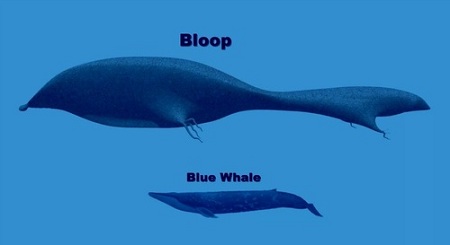Bloop

บลุป (อังกฤษ: Bloop) เป็นชื่อเรียกของเสียงความถี่ต่ำมากใต้มหาสมุทรซึ่ง องค์การสมุทรและบรรยากาศแห่งชาติ (อังกฤษ: National Oceanic and Atmospheric Administration) ของสหรัฐอเมริกาสามารถตรวจจับได้ในช่วงฤดูร้อนของ พ.ศ. 2540 ต้นกำเนิดของบลุปยังเป็นปริศนา
ที่มาของบลุปนั้นสามารถระบุได้ว่าเป็นบริเวณ 50°S 100°W (ชายฝั่งตะวันตกเฉียงใต้ของทวีปอเมริกาใต้) ในมหาสมุทรแปซิฟิก บริเวณเส้นศูนย์สูตร ซึ่งใช้ระบบฟังเสียงใต้น้ำของนาวิกโยธินอเมริกาที่เดิมใช้ตรวจหาเรือดำน้ำของสหภาพโซเวียต สามารถจับเสียงของบลุปได้หลายครั้ง NOAA ได้บรรยายว่าบลุปนั้นมีความถี่สูงขึ้นเรื่อยๆเป็นเวลากว่าหนึ่งนาที และเป็นเสียงดังในบริเวณกว้างพอที่เซนเซอร์จำนวนมากในระยะกว่า 5,000 กิโลเมตรสามารถตรวจจับได้
นักวิทยาศาสตร์ซึ่งได้ศึกษาบลุป ระบุว่าบลุปมีลักษณะเหมือนเสียงของสัตว์ แต่ไม่มีสัตว์น้ำชนิดใดที่เรารู้จักซึ่งสามารถสร้างเสียงเช่นนี้ได้ ถ้าเสียงนี้มาจากสัตว์ มันต้องเป็นมีขนาดใหญ่กว่าวาฬสีน้ำเงินหลายเท่าตัว[1]
Bloop was an ultra-low-frequency and extremely powerful underwater sound detected by the U.S. National Oceanic and Atmospheric Administration (NOAA) in 1997. The sound was consistent with the noises generated by icequakes in large icebergs, or large icebergs scraping the ocean floor.[1]
The sound's source was roughly triangulated to 50°S 100°WCoordinates: 50°S 100°W (a remote point in the south Pacific Ocean west of the southern tip of South America), and the sound was detected several times by the Equatorial Pacific Ocean autonomous hydrophone array.[1] This system was developed as an autonomous array of hydrophones that could be deployed in any oceanographic region to monitor specific phenomena. It is primarily used to monitor undersea seismicity, ice noise, and marine mammal population and migration. This is a stand-alone system designed and built by NOAA's Pacific Marine Environmental Laboratory (PMEL) to augment NOAA's use of the U.S. Navy Sound Surveillance System (SOSUS), which was equipment originally designed to detect Soviet submarines.
According to the NOAA description, it "r[ose] rapidly in frequency over about one minute and was of sufficient amplitude to be heard on multiple sensors, at a range of over 5,000 km (3106.86 miles)." The NOAA's Dr. Christopher Fox did not believe its origin was man-made, such as a submarine or bomb, nor familiar geological events such as volcanoes or earthquakes. While the audio profile of Bloop does resemble that of a living creature,[2] the source was a mystery both because it was different from known sounds and because it was several times louder than the loudest recorded animal, the blue whale.[3] A number of other significant sounds have been named by NOAA: Julia, Train, Slow Down, Whistle and Upsweep.[4][5][6]
Dr. Christopher Fox of the NOAA initially speculated that Bloop may be ice calving in Antarctica.[7] A year later journalist David Wolman paraphrased Dr. Fox's updated opinion that it was probably animal in origin:[6]

From

No comments:
Post a Comment